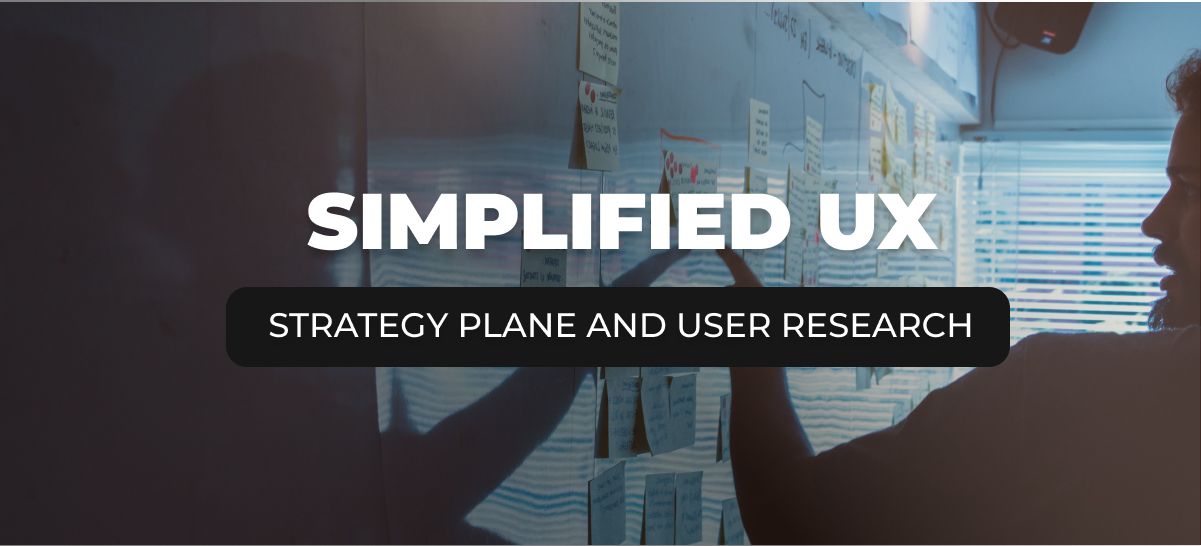This article is part of a series dedicated to providing a clear overview of UX design for beginners, primarily based on the work of Jesse James Garrett in his book, “The Elements of User Experience: User-Centered Design for the Web.”
To gain a foundational understanding of UX design, be sure to review our Complete Guide to Becoming a UX Designer before diving into user research and strategy.
In our previous article, titled “Simplified User Experience: From Complexity to Clarity,” we painted a broad picture of UX design and its process by exploring the Five Planes of the UX framework.
Here is a summary of the five planes framework:
- Strategy Plane: This is where we define project goals and user needs.
- Scope Plane: It specifies features, functionalities, and content.
- Structure Plane: Focuses on organizing information and user flow.
- Skeleton Plane: Deals with interface design and layout.
- Surface Plane: Involves visual design and aesthetics.
Together, these planes guide the creation of user-friendly and effective products.
In this article, we’ll take a closer look at the first of the five planes which is the strategy plane, a vital part of the product design process. As we delve into this topic, we’ll also explore user research, a critical discipline within UX. User research plays a key role in the strategy plan, underscoring its importance in creating great user experiences.

The Strategy Plane: Product objectives and user needs
The Strategy Plane, revolves around two fundamental questions: What do we want to get out of this product? and what do our users want to get out of it?
The first question guides us in defining clear product objectives, while the second one focuses on understanding user needs.
1 – Product Objectives:
Product objectives are central to the success of a website or any digital product. These objectives, driven by the organization’s internal goals, need to be clearly articulated and specific. They serve as the foundation for user experience design, guiding design decisions and ensuring alignment with organizational aims.
Determining product objectives is typically a collaborative effort involving various stakeholders within an organization. While it often starts at the executive or leadership level, it is crucial to involve cross-functional teams, including product managers, designers, developers, and user experience (UX) professionals.
Here are a few examples of clear product objectives:
- Increase Online Sales: For an e-commerce website, a primary product objective could be to increase online sales by a certain percentage over the next year. This objective is specific, measurable, and directly tied to the organization’s revenue goals.
- Reduce Customer Support Calls: A customer support knowledge base or FAQ section on a website may aim to reduce incoming customer support calls by a certain percentage. This objective focuses on improving user self-service and decreasing operational costs.
- Enhance Brand Engagement: A content-rich website for a media company might have an objective to enhance brand engagement by increasing the average time users spend on the site. This objective aligns with building a stronger brand identity.
- Improve User Retention: A mobile app may set an objective to improve user retention rates by a specific percentage. This goal is related to enhancing the user experience to keep users engaged over time.
- Boost User Sign-ups: A social networking platform could aim to boost user sign-ups by a particular number within a defined timeframe. This objective focuses on growing the user base, which can be vital for social platforms.
- Decrease Cart Abandonment: An online retail store might set an objective to reduce cart abandonment rates during the checkout process. This goal is directly tied to improving the conversion rate and revenue.
- Enhance Accessibility: An educational website may have an objective to enhance accessibility by conforming to specific accessibility standards, ensuring that all users, including those with disabilities, can access the content.
- Expand Global Reach: A software company may set an objective to expand its global reach by launching localized versions of its product in multiple languages, targeting specific international markets.
2 – Users Needs
One of the fundamental principles in design is to consider the user perspectives and requirement of the product rather than imposing the designer’s or CEO preferences.
To better understand user needs , there is a specialized discipline in UX design solely focused on researching and engaging with users, known as User Research.
User research
User research is a structured method for collecting, studying, and understanding information about a product’s target audience or users. Its main objective is to gain a thorough comprehension of user behaviors, needs, preferences, and challenges.
User research typically involves various methods and techniques, including:
- Surveys and Questionnaires: Researchers create surveys to collect quantitative data on user demographics, preferences, and opinions.
- Interviews: In-depth interviews with users help researchers gain qualitative insights into their motivations, challenges, and expectations.
- Usability Testing: Participants are observed while using a product or system to identify usability issues and gather feedback on its functionality and design.
- User Observations: Researchers directly observe users as they interact with a product, service, or system to understand their behavior, pain points, and areas for improvement.
- Contextual Inquiry: Researchers visit users in their natural environment to observe their daily tasks and gain insights into how a product fits into their routines.
- Card Sorting: This method is used to understand how users categorize information or content, helping improve the organization and navigation of websites or apps.
- Eye-Tracking: Specialized equipment is used to monitor where users look and focus their attention on a screen, providing insights into visual design and user engagement.
- A/B Testing: Users are divided into two groups, each exposed to a different version of a product or webpage. This helps determine which version performs better in terms of user engagement or conversion rates.
- Analytics Data Analysis: Researchers analyze data from web or application analytics tools to track user behavior, including page views, click-through rates, and user paths.
- Persona Development: Researchers create fictional user personas based on research findings to represent different user segments, making it easier to empathize with and design for target users.
- Prototyping and User Testing: Researchers create prototypes or mock-ups of a product or interface and conduct user testing to gather feedback on design concepts and functionality before development.
- Heatmaps: Heatmaps visually represent where users interact with a webpage or application, highlighting areas of interest and potential usability issues.
By addressing both product objectives and user needs, the Strategy Plane bridges the gap between organizational goals and user satisfaction, ensuring that the end product not only meets business objectives but also delights and fulfills the needs of its users. In the world of UX design, it’s all about finding the perfect balance between what the product aims to achieve and what users want to gain from it.
User research is key to a successful UX strategy. For more insights into how to become a UX designer, check out our Complete Guide to Becoming a UX Designer.
Conclusion
In this article, we’ve explored the Strategy Plane of UX design, which is really important when creating products. We’ve also introduced you to User Research, a key part of UX. It helps make sure products are enjoyable for people to use and meet their needs. Understanding both product goals and what users want is like finding a perfect balance in design.
In the next articles in this series, we’ll keep digging into the five planes framework of UX design. Stay tuned for more insights and knowledge as we dive deeper into the world of UX design!




